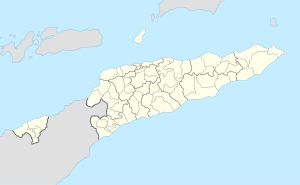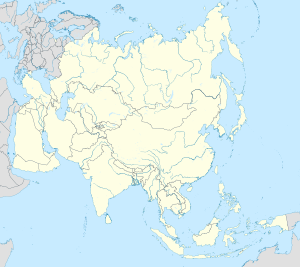
Back Dili ACE Dili Afrikaans ዲሊ Amharic ديلي Arabic ديلى (مدينه فى بلديه ديلى) ARZ Dili AST Dili Azerbaijani Дили Bashkir Dili BAN Dili BAR
Dili
Díli | |
|---|---|
Old Chinese Commercial Association building | |
 | |
| Coordinates: 08°33′13″S 125°34′42″E / 8.55361°S 125.57833°E | |
| Country | |
| Municipality | Dili |
| Capital of Portuguese Timor | 1769 |
| Government | |
| • Municipal administrator | Gregório da Cunha Saldanha |
| Area | |
| 178.62 km2 (68.97 sq mi) | |
| Elevation | 11 m (36 ft) |
| Population (2023) | |
| 277,488 | |
| • Density | 1,600/km2 (4,000/sq mi) |
| • Metro | 324,296 |
| Time zone | UTC+09:00 (TLT) |
Dili (Portuguese and Tetum: Díli) is the capital and largest city of East Timor. It lies on the northern coast of the island of Timor, in a small area of flat land hemmed in by mountains. The climate is tropical, with distinct wet and dry seasons. The city has served as the economic hub and chief port of what is now East Timor since its designation as the capital of Portuguese Timor in 1769. It also serves as the capital of the Dili Municipality, which includes some rural subdivisions in addition to the urban ones that make up the city itself. Dili's growing population is relatively youthful, being mostly of working age. The local language is Tetum; however, residents include many internal migrants from other areas of the country.
The initial settlement was situated in what is now the old quarter in the eastern side of the city. Centuries of Portuguese rule were interrupted in World War II, when Dili became the site of a battle between Allied and Japanese forces. The damaged city returned to Portuguese control following the war. In 1975, a civil war between Timorese political parties broke out, leading to a declaration of independence and a subsequent invasion by Indonesia. Under Indonesian rule infrastructure in the city was developed, with landmarks such as the Immaculate Conception Cathedral and Cristo Rei of Dili being built during this time. The city expanded as its population grew to over 100,000 people.
Resistance to Indonesian rule faced violent repression, and a massacre in Dili led to international pressure culminating in an independence referendum. Following a vote for independence violence erupted in the city, destroying huge amounts of its infrastructure and leading to an exodus of refugees. A period of United Nations rule followed, during which international agencies began the reconstruction of the city. Dili became the capital of an independent East Timor in 2002. A period of violence in 2006 saw another period of infrastructure damage and population displacement. In 2009 the government launched the City of Peace campaign to reduce tensions. As the population has continued to grow and the original site of the city has filled up, the urban area has expanded into coastal areas to the east and west of the main city.
Infrastructure in Dili continues to be developed. The city was the first location in East Timor to see 24 hours of electricity, although its water infrastructure remains relatively limited. Education levels are higher than the national average, and the country's universities are located in the city. An international port and airport lie within the city limits. Most economic activity comes from the tertiary sector and public employment. To further build the economy, the government is developing the tourism potential of the city, focusing on cultural, environmental, and historical attractions.









